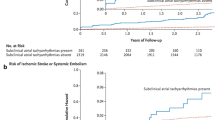Abstract
The clinical categorization of patients who present with atrial fibrillation is a major determinant of the most appropriate strategy for rhythm management. For those patients with recurrent atrial fibrillation that has not become permanent the two available strategies are rhythm control and anticoagulation or rate control and anticoagulation. There is no clear evidence that one of these strategies is superior to the other. In the AFFIRM trial these two strategies are being compared to one another in a randomized trial. Patients are randomly assigned to one of the two strategies and the treating physician then uses therapies from an approved menu as clinically indicated. Both pharmacologic and nonpharmacologic therapies are used. An overview of the main study protocol is presented. The primary endpoint is total mortality but there are a number of clinically important secondary endpoints. Several substudies will explore important ancillary questions and some of these are also described. At this time over 3000 patients have been enrolled and the planned enrollment is 4300. Enrollment will end late in 1999 and the last patient enrolled will be followed for two years. The AFFIRM Trial will provide important information concerning the management of atrial fibrillation in a large portion of the patients who have this arrhythmia.
Similar content being viewed by others
References
Planning and Steering Committees of the AFFIRM Study for the NHLBI AFFIRM Investigators. Atrial fibrillation follow-up investigation of rhythm management-The AFFIRM Study Design. Am J Cardiol 1997;79:1198–1202.
Atrial Fibrillation Investigators. Risk factors for stroke and efficacy of antithrombotic therapy in atrial fibrillation. Analysis of pooled data from five randomized controlled trials. Arch Intern Med 1994;154:1449–1457.
Crijns HG, Van Gelder IC, Van Gilst WH, Hillege H, Gosselink AM, Lie KI. Serial antiarrhythmic drug treatment to maintain sinus rhythm after electrical cardioversion for chronic atrial fibrillation or atrial flutter. Am J Cardiol 1991;68:335–341.
Page RL, Wilkinson WE, Clair WK, McCarthy EA, Pritchett ELC. Asymptomatic arrhythmias in patients with symptomatic paroxysmal atrial fibrillation and paroxysmal supraventricular tachycardia. Circulation 1994;89:224–227.
Grogan M, Smith HC, Gersh BJ, Wood DL. Left ventricular dysfunction due to atrial fibrillation in patients initially believed to have idiopathic dilated cardiomyopathy. Am J Cardiol 1992;69:1570–1573.
Geelen P, Goethals M, deBruyne B, Brugada P. A prospective hemodynamic evaluation of patients with chronic atrial fibrillation undergoing radiofrequency catheter ablation of the atrioventricular junction. Am J Cardiol 1997;80:1606–1609.
Coplen SE, Antman EM, Berlin JA, Hewitt P, Chalmers TC. Efficacy and safety of quinidine therapy for maintenance of sinus rhythm after cardioversion. A meta-analysis of randomized control trials. Circulation 1990;82:1106–1116.
Flaker GC, Blackshear JL, McBride R, Kronmal RA, Halperin JL, Hart RG. Antiarrhythmic drug therapy and cardiac mortality in atrial fibrillation. J Am Coll Cardiol 1992;20:527–532.
Kay GN, Ellenbogen KA, Giudici M, Redfield MM, Jenkins LS, Mianulli M, Wilkoff B. The Ablate and Pace Trial: A prospective study of catheter ablation of the AV conduction system and permanent pacemaker implantation for treatment of atrial fibrillation. J Intervent Cardiac Electrophysiol 1998;2:121–135.
Brignole M, Gianfranchi L, Menozzi C, Alboni P, Musso G, Bongiorni MG, Gasparini M, Raviele A, Lolli G, Paparella N, Acquarone S. Assessment of atrioventricular junction ablation and DDDR mode-switching pacemaker versus pharmacological treatment in patients with severely symptomatic paroxysmal atrial fibrillation. A randomized controlled study. Circulation 1997;96:2617–2624.
Twidale N, McDonald R, Nave K, Seal A. Comparison of the effects of AV nodal ablation versus AV nodal modification in patients with congestive heart failure and uncontrolled atrial fibrillation. Pacing Clin Electrophysiol 1998;21:641–651.
Lee SH, Chen SA, Tai CT, Chiang CE, Wen ZC, Cheng JJ, Ding YA, Chang MS. Comparisons of quality of life and cardiac performance after complete atrioventricular junction ablation and atrioventricular junction modification in patients with medically refractory atrial fibrillation. J Am Coll Cardiol 1998;31:637–644.
Echt DS, Liebson PR, Mitchell LB, Peters AW, Obias-Manno D, Barker AH, Arensberg D, Baker A, Friedman L, Greene HL, Huther ML, Richardson DW. Mortality and morbidity in patients receiving encainide, flecainide or placebo. The Cardiac Arrhythmia Suppression Trial. N Engl J Med 1991;324:781–788.
The Cardiac Arrhythmia Suppression Trial-II Investigators. Effect of the antiarrhythmic agent moricizine on survival after myocardial infarction. N Engl J Med 1992;327:227–233.
Kinch JW, Davidoff R. Prevention of embolic events after cardioversion of atrial fibrillation. Arch Intern Med 1995;155:1353–1360.
Mushlin AL, Hall WJ, Zwanziger JU, Gajary E, Andrews M, Marron R, Zou KH, Moss AJ. The cost-effectiveness of automatic implantable cardiac defibrillators: Results from MADIT. Circulation 1998;97:2129–2135.
Author information
Authors and Affiliations
Rights and permissions
About this article
Cite this article
Wyse, D.G. The AFFIRM Trial: Main Trial and Substudies—What Can We Expect?. J Interv Card Electrophysiol 4 (Suppl 1), 171–176 (2000). https://doi.org/10.1023/A:1009815606734
Issue Date:
DOI: https://doi.org/10.1023/A:1009815606734




